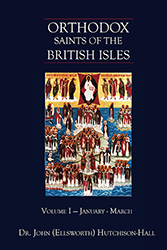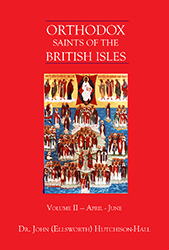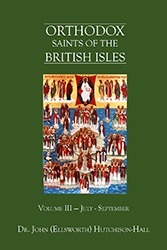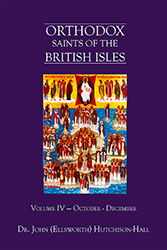
Orthodox Saints of the Pre-Schism
See of Rome
29th November (NS) — 16th November (OS) 2023
ÆLFRIC (AELFRIC), there has always been a certain amount of confusion about the life of St. Ælfric. It is possible that St. Ælfric commenced his monastic life at Abington Abbey in his early years, and he is referred to as Ælfric of Abington by some sources. In addition, the Historia Ecclesie Abbendonensis (History of the Church of Abingdon), lists St. Ælfric as an abbot, however, he is not mentioned in the actual abbatial lists. It is known that St. Ælfric served as the first abbot (c. 969 — c. 995) of St. Albans following its rebuilding at the instigation of King Offa II of Mercia. Following St. Ælfric’s consecration as the third Bishop of Ramsbury circa 992, it appears that he retained the abbotship of St. Albans for several years before his brother Leofric succeeded him sometime after 995. When St. Ælfric was translated to the See of Canterbury as the twenty-ninth Archbishop in 995, he remained Bishop of Ramsbury until his repose. Whilst Archbishop, St. Ælfric commissioned the first Life of St. Dunstan, and was at least on one occasion ordered by King Æthelred to adjudicate a case between local nobles. St. Ælfric reposed on 16th November 1005, and shortly afterwards was popularly acclaimed a saint. St. Ælfric was initially buried at Abington Abbey. However, during the reign of Cnut (1016 — 35) his relics were translated to Canterbury.
AFAN, a Welsh saint believed to be a grandson of Cunedda Wledig, king of Gwynedd, which would make him a cousin of St. David (1st March) as well. St. Afan was the founder of the parish church, now called Llanafan y Trawsgoed, of the village of Llanafan, near Aberystwyth in Ceredigion, Wales. This church was at one time apparently, a site of pilgrimages, and according to legend the site of at least one miracle, which an anonymous writer recorded as follows:
…the Anglo-Norman lord Philip de Braose, 2nd Lord of Bramber (c.1070 – c.1134) was hunting nearby and decided that the church was a suitable place for him and his dogs to spend the night. When he woke at sunrise, his dogs had gone mad and he was blind; his sight was only restored when he resolved to fight in the Crusades.
There is some debate as to whether St.Afan was a bishop or not, the exact year of St. Afan’s repose is unknown, though according to Baring-Gould St. Afan flourished in the early part of the sixth century.
Troparion of St. Afan — Tone I
Llanafan remembers thee, O Hierarch Afan,
thou teacher of piety, pastor, guide and inspirer of men's hearts.
Wherefore, O holy one, entreat Christ our God
that He will grant great mercy to our souls.
AFRICUS, (Seventh Century), the Confessor of Comminges in the foothills of the Pyrenees, little is known of St. Africus. He is often referred to as a bishop, although his name is absent from any of the lists of French bishops.
ELPIDIUS, MARCELLUS, EUSTOCHIUS, and COMPANIONS, St. Elpidius a senator, who bravely confessed the faith before Julian the Apostate. As a result, in 362, he and others were dragged, tied to the tails of wild horses, before finally being burnt at the stake.
EUCHERIUS, a married man who entered monastic life at Lérins in 422, while his wife, Galla, became a nun. They had two sons who also entered Lérins, and later both became bishops. In 434 St. Eucherius was consecrated Bishop of Lyons, in which See he served until his repose in 449. As bishop, he presided over the Council of Orange (441) with St. Hilary (5th May); and also wrote one of the greatly neglected spiritual works De Contemptu Mundi (On Contempt for the World).
FIDENTIUS, (Second Century), though nothing certain is known of his life, it is possible St. Fidentius was the third Bishop of Padua.
GOBRAIN, an early eighth century Bishop of Vannes in Brittany, who, at the age of eighty-seven resigned from his See and lived as a hermit until his repose in 725.
OTHMAR (OTMAR, AUDEMAR), a native of the ancient Roman province of Rhaetia who, in 720, was appointed Abbot of St. Gall. During the time of he was Abbot, St. Gall grew in wealth and importance. Unfortunately, this gave rise to designs on some of the Abbey’s property by two local nobles who captured and held St. Othmar prisoner, initially at the castle of Bodmann, then on the island of Werd in the Rhine, where, after six months, he reposed (759).
RUFINUS, MARK, VALERIUS, and COMPANIONS, (Date Unknown), according to tradition they were martyred in North Africa during one of the Roman persecutions, though nothing certain is known of their lives.
BLAISE and DEMETRIUS, (Date Unknown), martyrs at Veroli in Lazio, of whom no further information is extant.
BRENDAN of BIRR, founder of the Abbey of Birr in Offaly, which was the location of the Synod of Birr in 697, at which the Lex Innocentium, better known as Cáin Adomnáin (Law of Adomnán) was promulgated. The Abbey is also where the MacRegol or Rushworth Gospels, were produced c. 800.
St. Brendan began his monastic life as a disciple of St. Finian (12th December) at that great Irish nursery of saints of Clonard Abbey in present-day Co. Meath. At Clonard, St. Brendan was one of the group of students who went on to be known as the “Twelve Apostles of Ireland”, and is often known as St. Brendan the Elder to distinguish him from his better-known namesake and fellow student at Clonard St. Brendan the Voyager (16th May).
Despite being one of the lesser-known Apostles of Ireland, St. Brendan was an eminent church figure, as is evidenced by the epithet he was given of ‘Prophet of Ireland’. His eminence was further demonstrated by his defence of his close friend St. Columba (9th June) at the Synod of Meltown (in all likelihood c. 562), which prompted the synod to give St. Columba a sentence of exile, rather than excommunication over his role in the Battle of Cúl-drebene. Another consequence of St. Brendan’s long friendship and support for St. Columba was the development of close connexions between Birr and the various monasteries founded by St. Columba.
St. Brendan reposed circa 572, and at the moment of his repose St. Columba had a miraculous vision of St. Brendan’s soul carried by angels to Heaven.
Troparion of St. Brendan of Birr — Tone VIII
Most glorious ascetic and chief of Ireland's
Prophets, O Father Brendan, thou a bright beacon in the western isle guiding many to
salvation. At thy heavenly birthday the Angels rejoiced and miraculously announced their joy
to our Father Columba. The prayers of the
righteous avail much for us sinners. Wherefore
O Saint, pray to God for us that He will find
us a place in the Mansions of the Blest.
EGELWINE (ETHELWINE, AYLWINE), (Seventh Century), a prince of the House of Wessex, St. Egelwine abandoned the world and lived in great holiness as an anchorite at Athelney, Somerset, England.
GULSTAN (GUSTAN, CONSTANS), a disciple of St. Felix of Rhuys (4th March) at the Abbey of St. Gildas of Rhuys (29th January) in Brittany. St. Gulstan reposed circa 1010.
HARDOIN, a Briton who travelled to Brittany where he lived as a hermit and later served as Bishop of St. Pol-de-Léon. One legend states St. Hardoin was transported from the British Isles to Brittany in a stone boat propelled by angels. St. Hardoin reposed circa 650.
ILLUMINATA, a maiden, and possibly a martyr, in Todi, Umbria. St Illuminata reposed in the early fourth century.
RADBOD, consecrated fifteenth Bishop of Utrecht 900, he was forced to spend his final years in exile after his diocese was invaded by Vikings. St. Radbod reposed at Deventer in present-day Holland 917.
Troparion of St. Sadwen — Tone VIII
The remoteness of the Welsh mountains was
thy desert, O Father Sadwen, where thou didst
serve God in fasting and humility.
May thy continual intercession avail
for us sinners that our souls may be saved.
SADWRN (SADWEN), (Sixth Century), brother of St. Illtyd (6th November) and disciple of St. Cadfan (1st November). As is the case with his brother, nothing known of St. Sadwrn’s life and without the existence of churches in Wales dedicated to him, his existence might have been completely overlooked.
SATURNINUS (SERNIN), sent to help revitalise Christianity in Gaul following the Decian Persecution (250 – 251). St. Saturninus worked mainly in Toulouse and environs, serving as the first Bishop of Toulouse. He was martyred (circa 257) by the area’s pagan priests for his refusal to worship idols. There are several legends which link him with evangelism in other parts of Gaul and the Iberian Peninsula however, these are not historically verifiable.
SATURNINUS and SISINIUS, though there are no reliable details extant, it is thought that St. Saturninus was a native of Carthage who served as a priest in Rome. There, he, and his deacon Sisinius, were arrested during the persecutions under Emperor Maximian. They were then either sentenced to hard labour and worked to death, or were tortured and beheaded circa 257, and then buried on the Via Saleria, Rome.
WALDERIC, under the patronage of King Louis the Pious, St. Walderic founded and served as first Abbot of a monastery at Murrhardt, Swabia. St. Walderic reposed circa 817.
Prior to the Schism the Patriarchate of Rome was Orthodox, and fully in communion with the Orthodox Church. As Saint John of Shanghai and San Francisco +1966 said “The West was Orthodox for a thousand years, and her venerable Liturgy is far older than any of her heresies”.
Details of British Saints excerpted from Orthodox Saints of the British Isles.
Details of continental saints from these sources.
In many cases there are several spelling versions of the names of saints from the British Isles. I use the Oxford Dictionary of National Biography version as the primary version with the more prevalent version in parenthesis e.g. Ceadda (Chad) of Lichfield.




